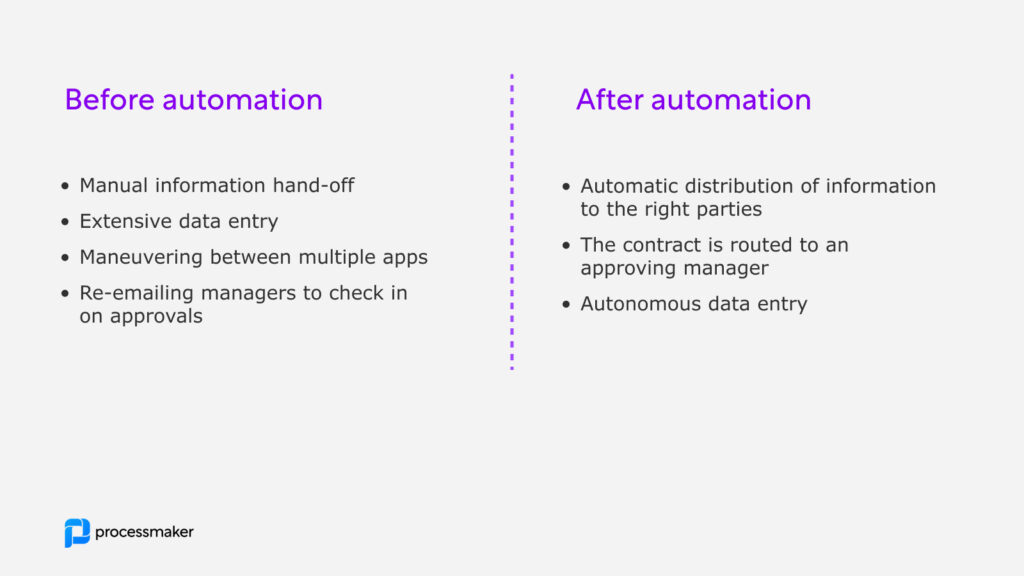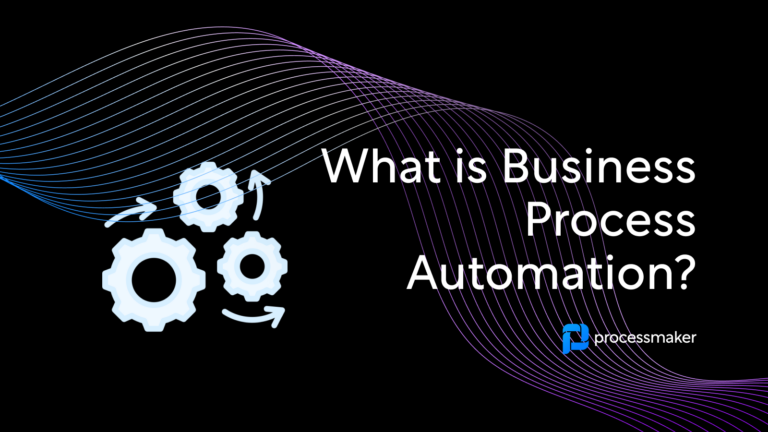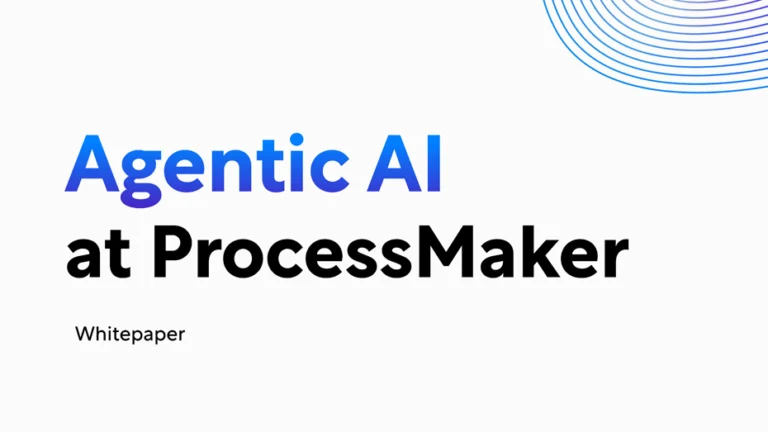What would you do with an extra 2.5 hours in your workday? For most people, the question is pointless. “Finding more time” is a nearly impossible feat.
Researchers conducted a study on 2,000 workers. The study revealed that on average, workers spend more than 142 minutes each day on administrative tasks, paperwork, and data entry. We’re so busy with busy work, that 90% of us don’t have time in our day to focus on creative business ideas.
Cashing in time savings isn’t a simple currency exchange: you’ve got to pick the right technologies for success. Leading the pack is business process automation (BPA).
What is Business Process Automation?
Consider all the steps involved in common procedures like paying an invoice, preparing an expense report, or asking your manager for a run of vacation days. Going through the motions manually and step-by-step can take hours. Including follow-ups, many can take days or weeks.
Business process automation enables us to shift the responsibility for these productivity-draining tasks over to technology. Instead of spending 15 weeks each year on mundane tasks, we can use software to do them for us.
Business process automation uses technology to automate manual tasks, accelerating their speed dramatically and enhancing operational efficiency.
How? Automated systems can fill out forms, send emails, coordinate between people, validate data, and more. With BPA and intelligent automation, organizations can reduce their reliance on human intervention by automating a range of repetitive tasks.
Compared to a simple task management platform, BPA helps you create, control, and manage complex workflows at scale. The strategy centralizes all of the processes that churn through your organization into one portal.
Commonly automated tasks and processes in BPA:
- Routine data entry
- Populating spreadsheets or databases
- Onboarding new employees or offboarding departing staff
- Reviewing time-off requests
- Complex workflows (e.g., opening new bank accounts)
- Report generation
- Process paperwork
- Content marketing approvals
- Auto-populating agreements and other documents with information from your CRM
- Filling out spreadsheets
- Validating data
Business process automation tools play a crucial role in automating these tasks, enhancing workflow customization, and improving overall business productivity.
Why is business process automation important?
Automation can help unleash the untapped potential of your best team members in digital transformation. By freeing them from manual tasks, they can focus on more revenue-generating activities that drive company growth. In general, business process automation helps organizations:
- Accelerate everyday operations
- Make informed decisions faster
- Eliminate process bottlenecks
- Reduce regulatory risks
- Eliminate manual/paper-based processes
What are the benefits of business process automation?
Process automation provides a wealth of benefits for your organization. It’s no wonder two-thirds of companies now lean heavily on automation. Here are five reasons to automate your tasks:
Improved Efficiency
Efficiency is one of the major benefits of business process automation. McKinsey showcases it amongst BPA’s most stunning advantages. Industries using the BPA strategy experience a 20–35% efficiency boost while reducing processing timelines by more than half.
Accuracy
Manual tasks are prone to errors, such as errant keystrokes and data entry mistakes. Just 290 seconds into its mission, one typo ended Mariner 1’s mission to Venus. The missing hyphen cost NASA $80 million. BPA is just the trick to patch up processes prone to human error.
Customer satisfaction
Business process automation can improve customer satisfaction by providing faster and more accurate service. There’s nothing more frustrating for a customer than a lack of updates. Whether they’re waiting for you to approve a mortgage or process a return, slow response times send customer satisfaction into a nosedive. Over 30% of customers will leave after one unpleasant experience—even from their most beloved brands. Using process automation, you’ll have real-time insight throughout a process journey. Provide customers with timely updates, and let them know if there are any hold-ups like missing information.
Productivity
BPA is also a boon to your internal productivity. Shockingly, only half of employees fully know their job’s expectations. BPA clearly defines responsibilities and helps teams see how their contributions add up to the greater good while giving anyone a peek into overall progress. Accenture predicts artificial intelligence-infused workflows can boost productivity by up to 40%—an attractive statistic for anyone looking to get more out of their existing workforce.
Cost savings
Business process automation can significantly cut down costs by taking on the burden of mundane admin tasks, freeing team members to focus on driving the business forward. In some industries, unnecessary busy work can drain losses of over $530 billion per year. Companies can rack up significant savings by turning these responsibilities over to machines.
How does business process automation work?
BPA enables multiple apps to “speak” to each other. For example, a marketing team member can stitch together a few apps to streamline portions of a workflow. This could include a new email address to the CRM and a separate email marketing platform.
An effective BPA strategy includes more than a handful of automation performing tasks scattered across your organization. A robust process automation system not only automates repetitive tasks but also enhances accountability, provides valuable insights, and supports continuous process improvement, ultimately enabling organizations to adopt digital transformation.
Business process automation is not a niche strategy. It’s open to all industries and departments. Marketing, sales, HR, accounting, and supply chain managers can tap into BPA’s benefits. See how these three very different companies are using it.
Using BPA in Operations
Coca-Cola Mexico implemented BPA to automate the quality and compliance standards processes for their thousands of suppliers.
- The solution allows new suppliers to submit their requests via a digital form.
- The information immediately routes to due diligence reviewers within different Coca-Cola departments.
- After confirming the soft drink empire’s rigorous quality and compliance standards, suppliers are approved to work with Coca-Cola.
The solution reduced processing time, increased transparency, and improved supply chain traceability within their operations.
How a real bank benefits from BPA
GTBank needed more customization and scalability in its critical financial processes. Many tasks were happening at individual branches, beleaguering communication and department collaboration.
GTBank turned to a BPM platform to centralize processing, integrate with Swift Financial Messaging Service for foreign exchange transactions, and increase automation across all branches using digital process automation software.
Using BPA, the bank achieved end-to-end automation of critical processes, empowered customers with self-service apps, and redefined its IT department’s workflows. Today, GTBank has 7,500 users working 20,000 cases through the system—making their BPA platform the most used application at the bank. Read the BPA banking case study
How BPA can benefit healthcare organizations
Kaiser Permanente’s regional office struggled with managing equipment, capital, and staffing requests. These processes involved complex instructions and multiple spreadsheets, making identifying errors and tracking progress hard for business users.
To streamline these processes, Kaiser Permanente turned to customized BPM automation. The automated workflows transformed three of the most important financial processes, eliminating manual tasks and increasing productivity for the financial services team, now running over 1,500+ cases annually.
How to get started with Business Process Automation?
Ready to hop in and automate your business processes? Here’s a quick checklist to get your plan rolling.
1. Identify the best opportunities for automation
How do you choose the best processes to automate? Here are some ideal candidates and characteristics to watch for:
- High volume
- Repeatable
- Multiple times per day
- High impact to business
- Collaborative, shared between at least two different cross-functional departments
- External third party approval
- Require approval or input from multiple team members
- Regulatory compliance standards
- Error-prone and/or high risk
- Sensitive data
- Heavy manual data entry
- Mandated, requiring consistency
- Mundane and boring
While it’s tempting to automate everything, that doesn’t mean you should. Start with tasks that meet the above criteria and grow from there. Unsure where to begin? A no pressure process intelligence audit is a great starting point.
2. List the steps or map processes automatically
Traditionally, you would have to prepare a detailed process map yourself by asking around, interviewing people, and observing how the processes are done. Because this is such a manual procedure, the result would quite often be far from reality. Luckily, nowadays there are tools that can automatically map the processes for you with high accuracy.
3. Pick the best automation vendors
Once you’ve mapped out your process, explore the right software tools to automate them. Many are available, including workflow automation, robotic process automation, and BPM software. Ensure the software’s features match the exact needs of your core processes.
4. Train employees
Sell team members on the benefits of automation. According to Harvard Business Review, employees “not using it” is the main reason for tech roll-out failures. You can uncover potential resistance and pave over any speed bumps through ample upskilling.
5. Test, test, and test again!
Process automation is a favorite amongst professionals who’ve made a career chasing organizational excellence. Succeeding with BPA is a continuous pursuit. Keep testing your workflows, trying new sequences, and using AI tools to optimize task order.
The latest business process automation technologies
Now, let’s dig into how to automate tasks. Behind the scenes of every well-optimized workflow is a suite of technologies running the show. Organizations typically orchestrate their every move through a business process management platform (BPM).
Here, a BPM allows you to link up with all kinds of tools, integrating them into every step of your business. See how tech-savvy organizations use emerging tech to get the most out of their automation strategy.
Low-code automation and no code
Low code and no code platforms like ProcessMaker make task automation accessible to anyone. You don’t need to know complex programming languages to set things up. Building your next workflow is simple and intuitive with a drag and drop flowchart designer. Command low-code software through similar methods: drag-and-drop tools, whiteboard-style canvases, and easy-to-follow interfaces make automation a breeze. You can even take a picture of a whiteboard or napkin sketch and turn it into a functional process map.
Intelligent Document Processing (IDP)
BPA can also handle the dirty jobs behind processing many forms, applications, and other paperwork. Intelligent document processing, or document automation, outfits computers with a set of eyes, turning your systems into an always-on mega scanner. Uploads and attachments quickly ingest and follow a workflow of tasks—populate a spreadsheet with a doc’s data, transfer information between higher ed systems, and file for regulatory safekeeping, are just a few.
Using BPA and IDP document automation together, documents can be functional in your automation strategy.
Artificial Intelligence (AI)
Chatbots, data mining, pattern recognition—workflows can also run AI tools. In finance, you can use AI to identify suspicious behaviors and flag fraudulent activity. Customer service teams can use chatbots and virtual agents to converse with customers. Manufacturing companies tap AI to monitor equipment performance, predict maintenance needs, and identify the most convenient time to go down for repairs.
One report suggests that 72% of companies using AI to predict market conditions are confident in their ROI. With AI and automation working hand in hand, businesses can achieve greater speed, decision-making accuracy, and flexibility.
Robotic Process Automation (RPA)
Processes can ask for help along the way. One common helper is robotic process automation (RPA).
You can ask RPA to copy and paste a client name from a signed agreement into a CRM. It can also log into a database, retrieve information, and add its findings to another application. Provide a strict list of instructions—keystrokes, clicks, commands—and RPA bots follow it thoroughly. RPA’s penchant for perfection is its main advantage, saving companies over 25,000 hours of avoidable rework annually.
Application Programming Interfaces (API)
APIs connect two or more applications. An API like a hotel keycard: it gives an authorized app access to specific data. Amazon’s Alexa isn’t a meteorologist; the company can grab your local weather conditions from AccuWeather through an API.
A task within a workflow sequence can include API integration. For example, a travel booking website coordinates with a hotel’s reservation service to check availability and claim your room dates. An online retailer can sync real-time Shopify sales with their ERP. APIs help you tap into extremely valuable automation that brings together your operations.
Business process analysis and automation
Business process analysis and automation are two sides of the same coin, both essential for enhancing operational efficiency. Process analysis involves examining your current processes to identify areas for improvement, while business process automation uses technology to implement those improvements. By combining these practices, organizations can achieve significant benefits:
- Improve operational efficiency: Automating repetitive tasks and streamlining processes can drastically reduce the time and effort required to complete them. For example, automating the approval process for expense reports can eliminate delays and ensure timely reimbursements.
- Enhance customer experience: Faster and more accurate processes lead to better customer service. Automated systems can provide real-time updates and quicker responses, improving overall customer satisfaction.
- Increase productivity: Automation frees up employees to focus on higher-value tasks. Instead of spending hours on data entry, they can work on strategic projects that drive business growth.
Consider a retail company that automates its inventory management. By using BPA, the company can automatically update stock levels, reorder products, and generate sales reports. This not only improves efficiency but also ensures that customers always find the products they need. In summary, business process analysis and automation work hand in hand to create more efficient, productive, and customer-centric organizations.
BPA vs. BPM: What’s the difference?
To better understand business process automation, let’s look at its not-so-distant cousin: business process management (BPM). BPA is digitizing and automating tasks, while BPM is managing and monitoring workflows from start to finish.
From a software standpoint, BPA performs the automation. A BPA platform offers the comprehensive architecture needed for an organization to manage every process it automates. It helps route tasks through various individuals, departments, and software tools. BPA platforms also give you the ability to cohesively monitor their progress from a central hub.
A process automation platform should be low-code, meaning workers of all proficiency levels can wield it. By using simple drag-and-drop apps, sales managers and customer service representatives can collaborate on workflow design. These “citizen developers” can easily pull advanced technologies like intelligent document processing (IDP) or artificial intelligence into the fold to extend automation beyond basic data pulls. Also known as digital process automation, these AI-infused platforms:
- Connect legacy systems to third-party software to enhance process automation
- Leverage third-party AI integrations machine learning and robotic process automation (RPA) to perform more complex jobs like reading and extracting information from documents
- Make sense of unstructured data
- Learn and improve from experience
- Improve the customer and employee experience
- Reduce operational costs and drive revenue
Digital process automation injects AI into all of your systems to minimize manual data handling. Using faster software can speed up decision-making and information processing in your organization.
Business process automation in action (sales contract example)
Sales reps traditionally spend a significant portion of their workday on administrative tasks—from compiling reports to creating lists to generating contracts. Let’s look at one common scenario, contract generation for sales teams, to see how BPA can free up valuable time.

Contract generation without automation:
- Sales reps manually prepare the final agreement once it’s time to close a new account. This multi-step process requires logging into their CRM, copying client data, and pasting it into a preformatted document.
- Sales reps contact the accounting department to share the contract terms. Someone else then enters the pertinent data into a few different fields.
- Sales reps send the contract to their manager for approval. Then they go to the accounting department to create customer accounts for payment processing.
- Finally, the sales team shuttles the information to the customer service team. The support team had to spend a lot of time and effort due to an incorrect account number. They had to search for the caller’s account.
Contract generation with automation:
- With the click of a button, a sales rep pulls data into a pre-formatted template to create a contract.
- This triggers a sequence of tasks that run in parallel. For example, a new profile is automatically created in both the accounting and customer service software.
- The contract is automatically sent up the approval ladder. Managers can approve the contract within the body of an email without leaving their email client.
- The system adds a step to alert the account manager when the customer contacts customer service. They can step in and handle any concerns with white-glove treatment.
Using BPA, organizations don’t just reduce the number of manual steps required to get things done. They also integrate various disparate systems to form one well-connected and highly efficient machine.
How to get started with business process automation
Embracing business process automation may seem scary at first, but it’s easier than you think. We recommend three steps: start small with one process, define your business logic, and choose an automation platform that can meet the needs of the business not only as it is but as it grows.
Chat with one of our intelligent automation experts to start your automation journey today.





